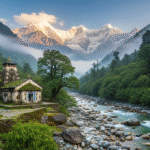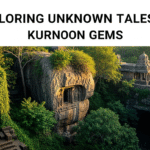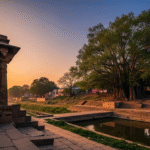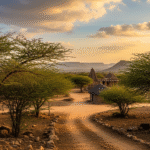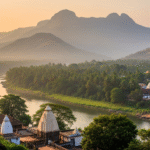National Geographic recognized Kakkathuruthu, an Indian island, in its ‘Around the world in 24 hours’ list. This shows India’s secret beauties, quiet and away from busy tourist spots. The country has a wide range of geography. Yet, many of its hidden islands stay unknown. From Andaman’s Swaraj Dweep with beautiful beaches to Umananda, the world’s smallest inhabited river island, India calls to those who love to explore.
The Lakshadweep Islands offer great scuba diving and snorkeling with their vibrant marine life. For those looking for peace and culture, Assam’s Majuli Island is perfect. It’s peaceful, and you can only get there by ferry from Jorhat. Each island has its own story, like Hope Island’s small community of 400 families by the Andhra Pradesh coast. Rameshwaram Island’s views of the Bay of Bengal amaze everyone.
India’s lesser-known islands are where history, culture, and nature meet. They offer true experiences far from common tourist paths. These places, full of heritage and stunning views, are perfect for adventurers wanting to explore India’s secret gems.
Key Takeaways
- Kakkathuruthu has earned a spot on a distinguished international list, highlighting its global allure.
- Swaraj Dweep in the Andamans and Umananda highlight the scale of India’s island diversity, from expansive to incredibly petite.
- The Lakshadweep Islands are not just for relaxation but a paradise for underwater adventure.
- Majuli and other hidden islands in India provide a pure cultural immersion away from mainstream destinations.
- Hope Island illustrates the intimacy of India’s less frequented locales, offering unprecedented peace.
- Netrani Island’s waters provide unmatched clarity for marine enthusiasts to indulge in.
- Seasonal tip: the optimal time to embark on an island adventure in most regions is between October and March, aligning with India’s pleasant post-monsoon climate.
Unveiling the Hidden Beauty of India’s Islands
India’s long coastline stretches 7,517 kilometers along three major bodies of water. It is home to secluded islands full of mystery and charm. These remote Indian islands attract travelers and help protect ecology and culture.
These islands are havens for wildlife and ancient cultures. For example, North Sentinel Island protects the Sentinalese tribe. Lakshadweep focuses on saving coral reefs from tourism and pollution.
Meanwhile, some islands like Divar in Goa and Majuli in Assam are easier to visit. Divar is known for its calm beauty and festivals. Majuli shows off nature and Assamese culture, being a large river island.
These secret islands in India are not just about beauty. They show how humans and nature can coexist. Visiting these islands teaches us to explore without harming.
Even islands like Barren Island, with South Asia’s only active volcano, teach us balance. Visitors must follow strict safety rules because of its active volcano.
India’s islands teach us about being careful, curious, and wanting to save the planet. They show untouched nature and old ways of life, urging us to protect them. Thus, these secluded islands highlight India’s dedication to its hidden gems.
Delving into Aurangabad’s Lesser-Known Caverns
The famous Ajanta and Ellora caves get a lot of attention. Yet, Aurangabad has forgotten caves with deep stories of India’s past. These hidden caves show us old religious and art practices. And they’ve been waiting in silence, made of stone.
Artistic Heritage in Rock-cut Temples
In Maharashtra’s rugged lands, the caves near Aurangabad are peaceful places. They show ancient artists’ skills in stone. These rock temples are famous for their beauty and stories. They tell of gods and deep thoughts from India’s great art times.
An Encounter with Ancient Sculptures
The Aurangabad caves have many sculptures that grab your heart. They mix Buddhist figures with Hindu gods beautifully. These pieces offer a quiet talk on old beliefs and beauty. They make the caves a special place of India’s art story.
In Maharashtra, these caves break the silence of time, showing India’s art and spirit climb. Visitors enter a dream of the past and present. They hear the artists’ tools and old tales whispered softly.
Gokarna: A Quiet Counterpart to Goa’s Bustle
Gokarna is very different from lively Goa. It’s a peaceful place that lets visitors enjoy a calm escape. It’s known as one of India’s most peaceful places. Here, beauty is simple but deep.
This place has quiet beaches and a strong spiritual feel. It offers a deep connection with oneself, away from busy tourist spots. One can relax on Gokarna Main Beach. Or explore the quiet beauty of Om and Kudle Beach.
Activities in Gokarna match its calm vibe. You can do yoga or trek for stunning views. The food here is also great, with many local and international dishes to try.
The best time to visit Gokarna is from October to March. This is when the weather is nice. There are many places to stay, from small beach cottages to affordable hotels. Everyone can find a perfect spot.
Gokarna is special because it’s peaceful but still full of things to see and do. Time seems to slow down here. It’s a place to refresh your spirit and enjoy nature’s untouched beauty.
Mawlynnong: Asia’s Cleanest Village Beckons
Tucked away in Meghalaya’s lush greenery, Mawlynnong stands out. It’s Asia’s cleanest village. The village shows a strong commitment to keeping the environment clean and living sustainably. It’s not just beautiful but also a lesson in eco-friendliness. It offers a window to the lesser-known Northeast Indian islands too.
Mawlynnong’s famed living root bridges highlight its sustainable approach. They are made by the Khasi tribes from rubber tree roots. These bridges aren’t just useful; they attract those looking for unique experiences in India’s unknown islands.
The Living Root Bridges of Meghalaya
The living root bridges show a deep connection between the Khasi tribe and nature. They draw visitors worldwide. Found in Meghalaya’s dense forests, these bridges cross streams and rivers. They form a natural network that is impressive and useful.
Nature’s Own Artwork in Full Bloom
Mawlynnong’s environment is rich with diverse plant and animal life. The village is well-kept, respecting nature deeply. It looks like a scene from a fairy tale, with blooming flowers and vibrant greenery everywhere.

The village’s focus on cleanliness and harmony with nature is exemplary. A visit to Mawlynnong is refreshing and enlightening. It shows how the village has maintained its beauty and cleanliness. Community efforts make Mawlynnong a sustainable living example for the world.
| Feature | Mawlynnong | Other Northeast Indian Locations |
|---|---|---|
| Cleanliness | Internationally recognized as the cleanest | Varies, generally clean |
| Natural Attractions | Living root bridges, lush greenery | Tawang Monastery, Nuranang Falls |
| Cultural Significance | Strong community involvement | Diverse, with many tribal cultures |
| Accessibility | Accessible via road, guided tours available | Varies, some areas remote |
Mawlynnong is perfect for eco-tourists, culture lovers, or anyone wanting a peaceful retreat. It offers a deep dive into living in harmony with nature. Visitors can learn and enjoy the beautiful blend of nature and culture here.
The Ethereal Pangong Tso: A High-Altitude Escape
Pangong Tso in Ladakh sits high where the air tells tales of silence and solitude. About 160 km from Leh, this lake reflects Ladakh’s raw beauty. Its majestic nature truly speaks to those visiting. The journey to the lake is an adventure. It calls to those wanting to feel nature away from busy city life.
As dusk comes, the lake shows a magical view under the sky. Stars dance on its calm surface. This beautiful scene makes Pangong Tso a unique place. Each visit brings a new, starry story to life.
Pangong Tso, a spectacle in Ladakh, offers an introspective journey through the cosmos reflected in its serene waters.
To get to this peaceful place, Leh Kushok Bakula Rimpochee Airport is the closest airport. It connects to big cities in India. The best time to visit is from May to September. During this time, the place is colorful yet cool. It’s perfect for those looking for peace. Photographers will find Pangong Tso’s beauty inspiring.
| Location | Distance from Leh | Best Visit Time | Nearest Airport |
|---|---|---|---|
| Pangong Tso, Ladakh | 160 km | May to September | Leh Kushok Bakula Rimpochee Airport |
In winter, Pangong Tso becomes a crystal wonderland. Brave hearts enjoy winter festivals and the moon-like icy lake. Yet, its true beauty shines in the warmer, lively months. Then, it is one of the most stunning places, remote yet alive.
Hampi: Echoes of a Forgotten Empire
In Karnataka, Hampi is a lovely spot that draws history buffs and adventurers. It’s a hidden gem in India with incredible ruins. These ruins were once the heart of culture and politics. Now, they inspire all who visit.

Hampi has over 1600 temples, showing its rich history. The architecture of these temples is amazing. The ancient temples stand amidst nature, showing human skill and beauty.
Stones Whispering Ancient Legends
Old temples and markets in Hampi whisper secrets. These places show how people once lived and prayed. Here, stones share tales blending myth and history.
The Timeless Ruins of Vijayanagara
Hampi’s ruins are from the glorious Vijayanagara empire. This place was once very famous. Now, it’s a must-see for those who love India’s history.
| Fact | Detail |
|---|---|
| Annual Visitors | Approximately 350,000 |
| Area of Temples | 4,187 hectares |
| Number of Temples | Over 1600 temples |
| World Heritage Status | UNESCO Protected |
| Popular Local Activity | Rock Climbing |
| Local Economics | Supported by entrepreneurs with hostels, restaurants, and shops |
| Conservation Efforts | Local communities participate actively in heritage preservation |
| Cultural Significance | Puppetry integral to cultural fabric |
In Hampi, every place tells its own story. From old markets to holy temples, each spot has a soul. It connects the past to the present beautifully.
Majuli: An Island Painting Cultural Dreams
Step into Majuli’s unique world, where Assamese arts brighten the spiritual vibe of this island. It’s in Assam’s heart, showcasing lasting heritage. Many come to see its wide cultural scene.
Here, history and craft merge, showing Majuli’s deep culture. It’s also an eco-haven, full of greenery and wildlife.
Tracing the Steps of Traditional Assamese Art
Hem Chandra Goswami’s mask-making takes us to Majuli’s art heart. These masks shine in Bhaona, showing the island’s festive spirit. They capture Majuli’s soul, holding great cultural value.
Majuli keeps its arts alive with festivals and shows. These events enchant visitors with dances and music, offering a rich cultural dive.
A Spiritual Journey Through Monasteries
Majuli’s story is told through its old monasteries or satras. These sacred places blend daily life with spirituality. Here, visitors learn from monks, discovering islander spirituality.
Each satra visit broadens one’s view on nature’s connection with mankind. Majuli’s calm makes it ideal for finding peace, away from city noise.
Majuli is more than an island. It’s a live canvas of Assam’s culture and spirit. Visiting here offers a mix of art and spirit emotions, standing out among spiritual destinations.
Khajjiar: India’s Answer to Switzerland’s Meadows
Khajjiar is in Himachal Pradesh. It looks a lot like mini Switzerland. It has green meadows, thick forests, and calm lakes. People love it for its natural beauty. It’s a hidden gem in India. It draws in those who love nature and adventure.
Khajjiar is very peaceful. It reminds people of Switzerland, which is why it’s called ‘Mini Switzerland of India.’ The area has green valleys. The air is cool and fresh. It makes you feel good. Plus, there are lots of things to do, which makes it great for tourists.
| Activity | Best Months | Entry Fee (INR) |
|---|---|---|
| Wildlife Sanctuary Visit | April to October | 250 for Indian visitors, 800 for foreign visitors |
| Adventure Sports | March to June, September to November | N/A |
| Temple Visits | All Year | Free |
The best time to go to Khajjiar is between March and September. Stay away during July and August because of the heavy rains. If you like adventure, there are many fun activities like paragliding and horseback riding. The green valleys are beautiful. For peace, visit the Nag Temple and the Golden Devi Temple. They are open all year.
Khajjiar is close to other places worth visiting too. It’s a short drive from Dalhousie and not far from Mcleodganj. This makes Khajjiar a great starting point to see more of Himachal Pradesh. The roads are good, so it’s easy to get there. This place is perfect for seeing the mini Switzerland of India.
In conclusion, Khajjiar has lots to offer. You can find thrilling activities and quiet places to rest. Its beauty is still very natural. There are many things to do and beautiful places to see. It’s a place you should visit if you love nature.
Nagaland’s Dzukou Valley: Where Earth Meets Sky
Dzukou Valley is high up, at about 2,400 meters. It covers 27 square kilometers. It’s one of India’s secret spots, peaceful and full of nature.
You start heading to Dzukou Valley from Zakhama or Viswema village. The trek takes about 45 minutes to an hour. It’s a fun challenge for those who love the outdoors.
Each season in Dzukou Valley is different. June to July is great for seeing flowers. From September to November, it’s cooler with clear skies, perfect for tourists.
| Season | Visitor Experience |
|---|---|
| June – July | Lush green landscapes with vibrant flowers |
| September – November | Clear skies and cold nights ideal for trekking |
| Winter (Late December – January) | Accessible with potential light snowfall |
Dzukou Valley is beautiful but holds sad stories too. On December 26, 2014, a terrible accident happened. Three teens died after falling through ice. It’s a harsh reminder of nature’s dangers.
The views from Mt. Iso are magical. It’s the tallest peak there. The valley stretches far and wide. It’s not just a hike. It’s an experience of nature’s beauty.
Conclusion
The adventure in India’s hidden islands is amazing. We see places rich in culture and life. The Andaman and Nicobar Islands have 836 islands but only 31 are lived on.
Lakshadweep’s coral atolls are untouched and beautiful. Radhanagar Beach on Havelock Island is one of Asia’s best beaches. Port Blair is busy and shows another side of these islands.
Nature lovers will find joy in Marine National Parks and coral reefs. They can also hike in Mount Harriet National Park. Local cultures, like Minicoy Island’s Mahl-speaking people, are thriving. Visitors learn the importance of keeping nature safe while exploring. They see how important local traditions are. They can explore more here.
Cruise tourism helps these islands meet people from all over. It helps the local places make money and teaches everyone about keeping nature safe. Eco-tourism and working together keep these spots great.
India’s hidden islands offer more than a trip. They show us wild beauty and stories of people. Each visit helps us learn how to respect and enjoy these wonderful places.
FAQ
What are some hidden islands in India that remain largely undiscovered by tourists?
India’s less known islands include Munroe Island in Kerala with beautiful backwaters. Gokarna has serene beaches. Meghalaya’s Mawlynnong shows unique living root bridges. Ladakh’s Pangong Tso is breathtaking.
Where can I find secluded and off-the-beaten-path islands in India?
Look for secluded islands in places like the Lakshadweep Islands with untouched coral reefs. The Andaman and Nicobar archipelago is also remote, away from city noise.
What makes Aurangabad’s lesser-known caves worth visiting?
Aurangabad’s caves are special with ancient rock-cut temples and carvings. They’re quiet, offering a deep experience with India’s history and art.
What attracts travelers to Gokarna, and how does it differ from Goa?
Gokarna draws visitors for its calm, spiritual vibe and untouched beaches. It’s quieter than the lively beaches of Goa.
What is special about Mawlynnong and its living root bridges?
Mawlynnong is Asia’s cleanest village, famed for its living root bridges by the Khasi tribe. These bridges, made from rubber tree roots, show amazing natural architecture.
Why is Pangong Tso considered a high-altitude escape?
Pangong Tso in the Himalayas is a stunning blue lake for quiet retreats. The sky reflects in its waters, surrounded by mountains, creating a peaceful scene.
Can you describe the historical significance of Hampi’s ruins?
Hampi’s ruins mark the Vijayanagara Empire’s history. With grand temples and palaces, they tell stories of past glory and artistry.
How does Majuli represent Assam’s cultural heritage?
Majuli, the largest river island, reflects Assam’s culture. It has traditional arts, performances, and monasteries preserving ancient traditions.
What unique natural beauty does Khajjiar offer to visitors?
Khajjiar wows with its meadows, forests, and a lake, earning it the ‘Mini Switzerland of India’ title. It’s perfect for resting and enjoying nature.
What makes Dzukou Valley a must-visit spot for nature enthusiasts?
Dzukou Valley is loved by nature fans for its charming hills and flowers. It’s great for trekking and enjoying quiet beauty in Nagaland.
Why is it important to preserve the sanctity of India’s hidden islands?
Keeping India’s hidden islands intact is key to their beauty, biodiversity, and local traditions. Responsible travel helps protect these treasures without harming them.


